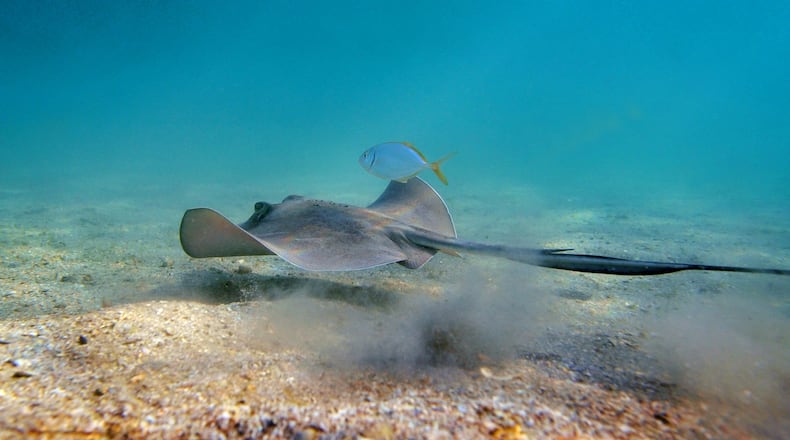A Palm Beach Gardens man is in the hospital after he was speared by a stingray off the coast of Riviera Beach on Monday afternoon.
The man, 19, was surfing when he suffered a severe injury he thought was a shark bite. He was taken to the trauma center at St. Mary’s, where doctors determined that he was injured by a stingray.
The barbed stinger barely missed his femoral artery, and he needed immediate surgery to fix his vascular system, according to a St. Mary’s spokesperson. After spending the night in the intensive care unit, he was moved to a regular room.
Stingray encounters can be deadly. Steve Irwin, better known as the "Crocodile Hunter" on TV, died after a freak stingray attack in chest-deep waters off Australia in September 2006. Initial reports stated Irwin tried to remove the stingray's barb from the area around his heart himself. His cameraman contradicted those reports eight years later, when he described Irwin "standing in a huge pool of blood."
After that incident, people began killing stingrays out of fear, said Rebecca Fago, the aquarium director and curator for the South Florida Science Center and Aquarium. There are a lot of misconceptions about the creatures, which generally don’t sting unless they feel threatened.
However, “threatening” them includes accidentally stepping on the creatures that nestle on the sea floor, said Amanda Smith, a fisheries biologist at the Florida Fish and Wildlife Research Institute.
Smith and Fago recommend beach-goers shuffle their feet when walking near the shore to rouse stingrays buried in the sand.
“Definitely do the stingray shuffle,” Smith said. “They’re going to move out of your way as long as you make your presence known.”
Stingrays are abundant on both Florida coasts, Smith said. The Atlantic, southern and bluntnose stingrays are the most common. Some stingrays are ground-dwellers that gravitate to the bottom of the ocean, and other swim through the water column, she said.
Both biologists said they’ve experienced the excruciating pain of a stingray’s barb. The severity of the sting depends on the species of stingray, Fago wrote in an email. She described the stinger as sharp “like a dagger” and wrote “the last thing anyone should do is try to remove the barb themselves.”
Tiny, backward-pointing teeth on the barb make it difficult to pull out without making the wound worse, Smith said. A young stingray’s barb is one or two inches long, whereas an adult barb is about five inches, Smith said. Some species have more than one.
There’s a difference in just getting scraped by a passing stingray and enduring a full-blown puncture, Smith said.
“It’s a very painful sensation. I was in tears all the way to the hospital one time,” she said. “If you can imagine like a scorpion, that’s basically the movement of the stingray.”
The stingray’s barb isn’t technically venomous, but it is coated with bacteria and proteins, Smith said. She recommends using vinegar, rubbing alcohol, bleach or even fresh water, if that’s all that’s available, to immediately flush the wound. Soaking the foot or ankle in hot water can help dull the pain on the way to the hospital, she said.
People who get stung should make sure the nurses or doctors thoroughly flush the wound at the hospital, Smith said. After one of Smith’s encounters, they didn’t make sure the injury was clean, and she ended up back at the hospital with severe cellulitis from her ankle to her knee.
“I could have possibly lost my leg. It just depends on the situation,” she said.
To prevent a stingray attack:
Do the ‘stingray shuffle.’ Shuffle your feet when walking along the shore or wading.
What to do if you catch a stingray’s barb:
- Don't try to remove it yourself.
- Flush the wound with rubbing alcohol, bleach, vinegar or even fresh water.
- Seek treatment at the hospital. They should flush the wound, too, and prescribe antibiotics.
Source: Amanda Smith, fisheries biologist at the Florida Fish and Wildlife Research Institute
About the Author
Keep Reading
The Latest
Featured



